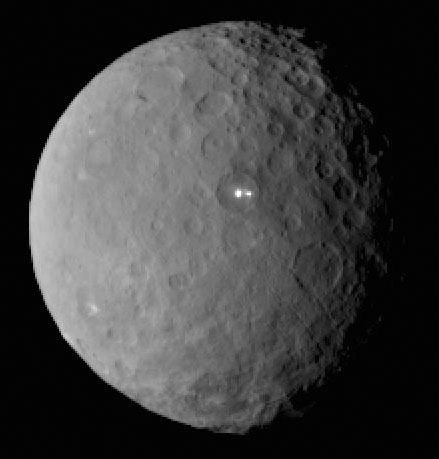Incoming views of the asteroid belt's largest body reveal spots where ice from the interior might be exposed on the surface.
NASA's Dawn spacecraft is just a few days from arriving at its second and final objective, asteroid 1 Ceres, on March 6th. Robert Mase, who manages the mission at the Jet Propulsion Laboratory in California, says Dawn will be captured into orbit at 4:20 a.m. (12:20 Universal Time). That's the first critical step in what promises to be an intensive, 16-month-long investigation.

NASA / JPL / UCLA / MPS / DLR / IDA
But images recently captured by the spacecraft's German-built camera already have mission scientists scratching their collective heads.Tucked inside a 57-mile-wide crater are two tiny spots far brighter than their surroundings. Images show a few other bright spots on Ceres. It's not yet clear what they are — the spots were smaller than the camera's resolution when the camera took its snapshots — but there's already plenty of speculation about them.
With an average diameter of 590 miles (950 kilometers), Ceres is the largest denizen of the asteroid belt. In fact, by the International Astronomical Union's definition, it qualifies as a dwarf planet. Unlike most asteroids, however, Ceres is thought to contain 25% water by mass — likely existing as a deep ice mantle overlying a rock-and-metal core. The surface we see might be little more than a veneer of rock and dust.
These bright spots "appear at low latitudes and stand out against the dark surface," notes Carol Raymond, Dawn's deputy project scientist. The pair in the crater are "extremely surprising to the team." She says the most likely cause is either fresh exposures of ice from recent impacts or small eruptions of slushy ice (cryovolcanism) from the interior. However, she notes, there's no indication that the spots are high-standing piles of erupted material.
Adding to the mystery is the fact that ESA's Herschel space spacecraft detected water vapor around Ceres when it scrutinized the big body in 2011, 2012, and 2013. But the detection was intermittent — and it now seems that water vapor was present when the two spots were in view. This bright pairing is "unique in the solar system," Raymond says, an enigmatic feature that "really has us on the edge of our seats."
Learn more about the spacecraft and the scientific studies planned for Ceres at the Dawn website.
 9
9









Comments
March 6, 2015 at 8:07 pm
Right now we can only speculate what those bright spots might be, but I believe it is reasonable to consider that they are most probably recent impact craters.
You must be logged in to post a comment.
Michael-Gamble
March 6, 2015 at 11:34 pm
I agree, that the possible bright spots are most likely impact craters.
You must be logged in to post a comment.
Peter Wilson
March 9, 2015 at 12:19 pm
Like the monolith found on the Moon in 2001, they could have been placed there intentionally.
Of course, that's just speculation.
You must be logged in to post a comment.
Kevin
March 7, 2015 at 12:58 pm
Since there is far less sunlight out there, I'm assuming that the exposure time is a bit longer than if you were imaging our Moon. If that's the case, would a longer exposure time tend to exaggerate the brightness of the spots? I'm speculating since I don't know the capabilities of the onboard camera but I'm sure it's better than the one in my phone.
It seems that the only reasonable explanation for these "Enigmatic White Spots" is water ice on the surface. Frozen CO2 (dry ice for the layman) lacks the shiny surface necessary for a bright reflection so if it is ice, it must be water ice. Hopefully Dawn will be able to figure out what the spots may be once it achieves a stable orbit and gets to work.
You must be logged in to post a comment.
Faye_Kane_girl_brain
March 8, 2015 at 8:35 am
=-
You know, that's a good point, Kevin. We may not be seeing brightness, but contrast. If that's so, then technically,it probably qualifies as an optical illusion.
And another thing. The main "light" is exactly where the central peak would be, and the smaller light is where material would fall back if the impactor hit at an angle.
I think we're looking at asteroid guts.
=faye
You must be logged in to post a comment.
Faye_Kane_girl_brain
March 8, 2015 at 8:47 am
==-
If the impactor was recent and made of the same anorthositic stuff as the lunar highlands with high aluminum (like 10%), perhaps it melted on impact and splattered like a coat of metallic paint.
One good thing about living here in The Future is that, unlike earlier planetary mysteries, this one won't remain a mystery for decades.
-faye
You must be logged in to post a comment.
March 8, 2015 at 10:41 am
Here's a link to NASA's website page that describes Dawn's specs, including her camera.
The link includes a full podcast lecture about the camera's construction and installation.
You must be logged in to post a comment.
March 8, 2015 at 10:41 am
http://dawn.jpl.nasa.gov/technology/science_payload.asp
You must be logged in to post a comment.
mriehl
March 8, 2015 at 11:59 pm
While I'm sure it is some artifact from a recent impact, that photo just makes me think of Arthur C. Clarke's short story, The Sentinel.
Mike
http://econtent.typepad.com/TheSentinel.pdf
You must be logged in to post a comment.
You must be logged in to post a comment.